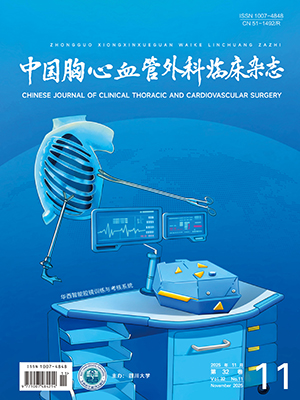| 1. |
Geil D, Thomas C, Zimmer A, et al. Chronified pain following operative procedures. Dtsch Arztebl Int, 2019, 116(15): 261-266.
|
| 2. |
Peng Z, Li H, Zhang C, et al. A retrospective study of chronic post-surgical pain following thoracic surgery: prevalence, risk factors, incidence of neuropathic component, and impact on qualify of life. PLoS One, 2014, 9(2): e90014.
|
| 3. |
Cui W, Li Y, Li S, et al. Systemic administration of lidocaine reduces morphine requirements and postoperative pain of patients undergoing thoracic surgery after propofol-remifentanil-based anaesthesia. Eur J Anaesthesiol, 2010, 27(1): 41-46.
|
| 4. |
朱云柯, 林琳, 廖虎, 等. 中國胸外科圍手術期疼痛管理專家共識(2018 版). 中國胸心血管外科臨床雜志, 2018, 25(11): 921-928.
|
| 5. |
劉子嘉, 張良燕, 鄭旭光, 等. 術中利多卡因持續靜脈泵入對胸腔鏡肺葉切除術患者阿片類用量及術后恢復的影響. 中國醫學科學院學報, 2018, 40(2): 163-169.
|
| 6. |
王萍, 丁登峰, 張俊志, 等. 靜脈注射利多卡因對胸腔鏡肺大皰切除術患者鎮痛的影響. 中國實驗診斷學, 2015, 19(7): 1134-1137.
|
| 7. |
Weibel S, Jelting Y, Pace NL, et al. Continuous intravenous perioperative lidocaine infusion for postoperative pain and recovery in adults. Cochrane Database Syst Rev, 2018, 6: CD009642.
|
| 8. |
Piccioni F, Segat M, Falini S, et al. Enhanced recovery pathways in thoracic surgery from Italian VATS Group: perioperative analgesia protocols. J Thorac Dis, 2018, 10(Suppl 4): S555-S563.
|
| 9. |
Slovack M, Taylor B, Bryce R, et al. Does intravenous lidocaine infusion during video-assisted thoracoscopic surgery reduce postoperative analgesia? A randomized controlled study. Can J Anaesth, 2015, 62(6): 676-677.
|
| 10. |
曲鳴宇. 利多卡因與右美托咪啶在胸腔鏡患者術后恢復的比較研究. 大連醫科大學, 2017.
|
| 11. |
Khan JS, Yousuf M, Victor JC, et al. An estimation for an appropriate end time for an intraoperative intravenous lidocaine infusion in bowel surgery: a comparative meta-analysis. J Clin Anesth, 2016, 28: 95-104.
|
| 12. |
Kosharskyy B, Almonte W, Shaparin N, et al. Intravenous infusions in chronic pain management. Pain Physician, 2013, 16(3): 231-249.
|
| 13. |
Moulin DE, Morley-Forster PK, Pirani Z, et al. Intravenous lidocaine in the management of chronic peripheral neuropathic pain: a randomized-controlled trial. Can J Anaesth, 2019, 66(7): 820-827.
|
| 14. |
Bailey M, Corcoran T, Schug S, et al. Perioperative lidocaine infusions for the prevention of chronic postsurgical pain: a systematic review and meta-analysis of efficacy and safety. Pain, 2018, 159(9): 1696-1704.
|
| 15. |
Kuo CP, Jao SW, Chen KM, et al. Comparison of the effects of thoracic epidural analgesia and i.v. infusion with lidocaine on cytokine response, postoperative pain and bowel function in patients undergoing colonic surgery. Br J Anaesth, 2006, 97(5): 640-646.
|
| 16. |
van der Wal SE, van den Heuvel SA, Radema SA, et al. The in vitro mechanisms and in vivo efficacy of intravenous lidocaine on the neuroinflammatory response in acute and chronic pain. Eur J Pain, 2016, 20(5): 655-674.
|
| 17. |
Yang W, Geng Y, Liu Y, et al. Comparison of effects of thoracic epidural and intravenous administration of lidocaine on target-controlled infusion of propofol and tracheal intubation response during induction of anesthesia. J Cardiothorac Vasc Anesth, 2013, 27(6): 1295-1300.
|
| 18. |
郭紅利. 不同劑量利多卡因對老年胸腔鏡肺切除術患者術后譫妄的影響. 西南醫科大學, 2018.
|
| 19. |
胡秀才, 齊英凱, 韓倩, 等. 利多卡因靜脈注射對雙腔氣管導管插管麻醉期間氣道壓力的影響. 中國實用醫藥, 2016, 11(21): 29-30.
|
| 20. |
Shuying L, Ping L, Juan N, et al. Different interventions in preventing opioid-induced cough: a meta-analysis. J Clin Anesth, 2016, 34: 440-447.
|
| 21. |
Ljungqvist O, Scott M, Fearon KC. Enhanced recovery after surgery: a review. JAMA Surg, 2017, 152(3): 292-298.
|
| 22. |
Suarez MA, Seddighi R, Egger CM, et al. Effect of fentanyl and lidocaine on the end-tidal sevoflurane concentration preventing motor movement in dogs. Am J Vet Res, 2017, 78(1): 12-16.
|
| 23. |
王萍, 李亞麗, 羅耀文, 等. 靜注利多卡因對老年胸腔鏡肺葉切除患者術后譫妄的影響. 實用醫學雜志, 2015, 31(16): 2740-2742.
|
| 24. |
Kulason K, Nouchi R, Hoshikawa Y, et al. Indication of cognitive change and associated risk factor after thoracic surgery in the elderly: a pilot study. Front Aging Neurosci, 2017, 9: 396.
|
| 25. |
Gholipour Baradari A, Habibi MR, Habibi V, et al. Administration of lidocaine to prevent cognitive deficit in patients undergoing coronary artery bypass grafting and valve plasty: a systematic review and meta-analysis. Expert Rev Clin Pharmacol, 2017, 10(2): 179-185.
|
| 26. |
游仁芳, 許福生, 王少平. 利多卡因對老年肺癌根治術患者圍術期腦氧代謝及術后早期認知功能影響. 臨床軍醫雜志, 2016, 44(1): 64-67, 71.
|
| 27. |
Habibi MR, Habibi V, Habibi A, et al. Lidocaine dose-response effect on postoperative cognitive deficit: meta-analysis and meta-regression. Expert Rev Clin Pharmacol, 2018, 11(4): 361-371.
|
| 28. |
黃重峰, 焦豐, 陳華敏, 等. 圍手術期利多卡因干預對老年胸科手術患者炎癥因子及術后認知功能的影響. 現代醫院, 2017, 17(3): 418-420, 424.
|
| 29. |
葉治, 郭曲練. 利多卡因的腦保護機制. 國際病理科學與臨床雜志, 2007, 27(5): 448-452.
|
| 30. |
吳德華, 馬靜雅, 徐益萍, 等. 不同麻醉方法下胸科手術老年病人術中房顫發生的比較: 大樣本臨床研究. 中華麻醉學雜志, 2017, 37(1): 34-38.
|
| 31. |
Onorati F, Dobson GP, San Biagio L, et al. Superior myocardial protection using "polarizing" adenosine, lidocaine, and Mg2+ cardioplegia in humans. J Am Coll Cardiol, 2016, 67(14): 1751-1753.
|
| 32. |
Kaczmarek DJ, Herzog C, Larmann J, et al. Lidocaine protects from myocardial damage due to ischemia and reperfusion in mice by its antiapoptotic effects. Anesthesiology, 2009, 110(5): 1041-1049.
|
| 33. |
王天佑. 胸外科圍手術期肺保護中國專家共識(2019 版). 中國胸心血管外科臨床雜志, 2019, 26(9): 835-842.
|
| 34. |
Misthos P, Katsaragakis S, Theodorou D, et al. The degree of oxidative stress is associated with major adverse effects after lung resection: a prospective study. Eur J Cardiothorac Surg, 2006, 29(4): 591-595.
|
| 35. |
Rancan L, Simón C, Marchal-Duval E, et al. Lidocaine administration controls microRNAs alterations observed after lung ischemia-reperfusion injury. Anesth Analg, 2016, 123(6): 1437-1447.
|
| 36. |
陳菲, 馬良, 王忠慧. 利多卡因對單肺通氣圍術期患者氧化應激反應的干預作用. 昆明醫科大學學報, 2015, 36(12): 77-79.
|
| 37. |
袁林芳, 趙文靜, 劉月, 等. 圍術期靜脈輸注利多卡因對食管癌患者的肺保護作用研究. 中國全科醫學, 2019. [Epub ahead of print].
|
| 38. |
Chen LJ, Ding YB, Ma PL, et al. The protective effect of lidocaine on lipopolysaccharide-induced acute lung injury in rats through NF-κB and p38 MAPK signaling pathway and excessive inflammatory responses. Eur Rev Med Pharmacol Sci, 2018, 22(7): 2099-2108.
|
| 39. |
Ohi M, Toiyama Y, Omura Y, et al. Risk factors and measures of pulmonary complications after thoracoscopic esophagectomy for esophageal cancer. Surg Today, 2019, 49(2): 176-186.
|
| 40. |
Hogan BV, Peter MB, Shenoy HG, et al. Surgery induced immunosuppression. Surgeon, 2011, 9(1): 38-43.
|
| 41. |
Freeman J, Crowley PD, Foley AG, et al. Effect of perioperative lidocaine, propofol and steroids on pulmonary metastasis in a murine model of breast cancer surgery. Cancers (Basel), 2019, 11(5): pii: E613.
|
| 42. |
Xing W, Chen DT, Pan JH, et al. Lidocaine induces apoptosis and suppresses tumor growth in human hepatocellular carcinoma cells in vitro and in a xenograft model in vivo. Anesthesiology, 2017, 126(5): 868-881.
|
| 43. |
Lucchinetti E, Awad AE, Rahman M, et al. Antiproliferative effects of local anesthetics on mesenchymal stem cells: potential implications for tumor spreading and wound healing. Anesthesiology, 2012, 116(4): 841-856.
|
| 44. |
Gao J, Hu H, Wang X. Clinically relevant concentrations of lidocaine inhibit tumor angiogenesis through suppressing VEGF/VEGFR2 signaling. Cancer Chemother Pharmacol, 2019, 83(6): 1007-1015.
|
| 45. |
Beaussier M, Parc Y, Guechot J, et al. Ropivacaine preperitoneal wound infusion for pain relief and prevention of incisional hyperalgesia after laparoscopic colorectal surgery: a randomized, triple-arm, double-blind controlled evaluation vs. intravenous lidocaine infusion, the CATCH study. Colorectal Dis, 2018, 20(6): 509-519.
|




